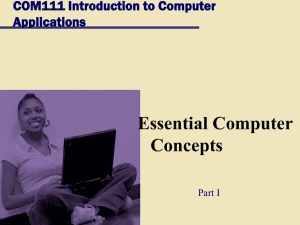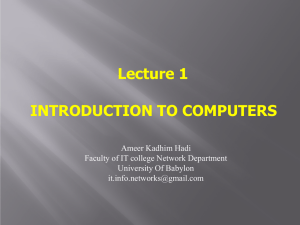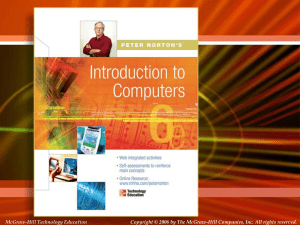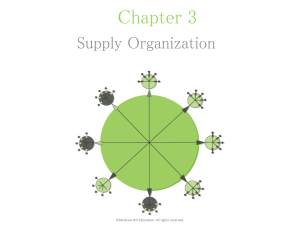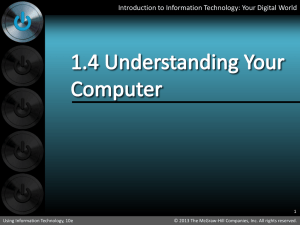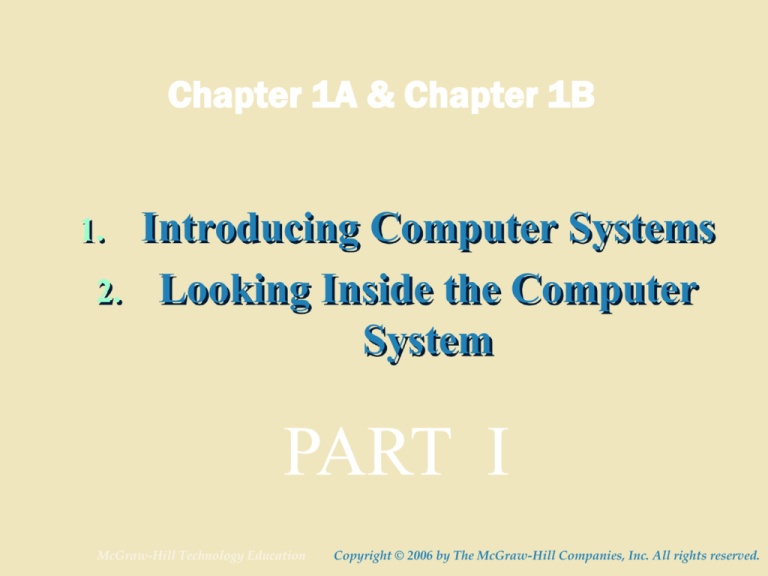
Chapter 1A & Chapter 1B
Introducing Computer Systems
2. Looking Inside the Computer
System
1.
PART I
McGraw-Hill Technology Education
Copyright © 2006 by The McGraw-Hill Companies, Inc. All rights reserved.
Chapter 1 Objectives
Recognize the importance of
computer literacy
Distinguish between system software
and application software
Define the term, computer
Describe the categories of computers
Identify the components
of a computer
Discuss the advantages and
disadvantages of using computers
Identify the elements of
an information system
Describe the various types
of computer users
Recognize the purpose of a network
Discuss the uses of the Internet and
World Wide Web
Discuss various computer
applications in society
Next
A World of Computers
What is computer literacy (digital literacy)?
Current knowledge and understanding
of computers and their uses
Computers are everywhere
Next
What Is a Computer?
How is a computer defined?
Electronic device operating under the control of
instructions stored in its own memory
Accepts data
Collection of
unprocessed items
Processes data into
information
Conveys meaning and is
useful to people
Produces and stores results
Next
Parts of the Computer System
Computer systems have four parts
Hardware
Software
Data
User
1B-5
Parts of the Computer System
Hardware
Mechanical devices in the computer
Anything that can be touched
Software
Tell the computer what to do
Also called a program
Thousands of programs exist
1B-6
Parts of the Computer System
Data
Pieces of information
Computer organize and present data
Users
People operating the computer
Most important part
Tell the computer what to do
1B-7
Information Processing Cycle
Steps followed to process data
Input
Processing
Output
Storage
1B-8
The Components of a Computer
What is an input device?
Hardware used
to enter data
and instructions
What is an output device?
Hardware that
conveys information
to one or more
people
What is the system unit?
Case that contains
the electronic components of
the computer that are used
to process data
Next
The Components of a Computer
What are two main components on the motherboard?
Processor
Also called a Central Processing Unit (CPU)
The electronic component that interprets and carries
out the basic instructions that operate the computer
Memory
Consists of electronic components that store
instructions waiting to be executed and data needed by
those instructions
Next
The Components of a Computer
What is storage?
Holds data, instructions, and information
for future use
Storage media
Physical material on which data, instructions,
and information are stored
Storage device
Records and retrieves items to and from
storage media
Next
The Components of a Computer
What is a USB flash drive?
Portable storage device
Small and lightweight enough
to be transported on a keychain
or in a pocket
The average USB flash drive
can hold about 2 billion
characters
Next
The Components of a Computer
What is a hard disk?
Provides greater storage
capacity than a
USB flash drive
Most are housed inside
the system unit
Next
The Components of a Computer
What is a compact disc?
Flat, round, portable metal disc
CD
DVD
Next
The Components of a Computer
What is a communications device?
Hardware component that
enables a computer to
send and receive data, instructions,
and information
Occurs over cables, telephone
lines, cellular radio networks,
satellites, and other
transmission media
Next
Advantages and Disadvantages
of Using Computers
What are the advantages of using computers?
Speed
Reliability
Storage
Consistency
Communications
Next
Advantages and Disadvantages
of Using Computers
What are the disadvantages of using computers?
Violation of
Privacy
Impact on
Labor Force
Public Safety
Health Risks
Impact on
Environment
Next
Networks and the Internet
What is a network?
Collection of computers and devices connected together,
often wirelessly
Used to share
Resources
Hardware
devices
Software
programs
Data
Information
Saves
time
and
money
Next
Networks and the Internet
What is a server?
A server controls
access to resources
on a network
Clients, or
workstations,
request resources
from the server
Next
Networks and the Internet
What is the Internet?
Worldwide collection of networks that connects
millions of businesses, government agencies, educational
institutions, and individuals
Next
Networks and the Internet
Why do users access the Internet?
1. Communications
2. Research and Information
3. Shopping
4. Banking and Investing
5. Classes
6. Entertainment
7. Download Music
8. Share Information
Next
Networks and the Internet
What is the Web?
Billions of documents, called Web pages, available to
anyone connected to the Internet
A Web site is
a collection of
related Web pages
You can share
information on a social
networking Web site or
a photo sharing
community
A Web page contains
text, graphics, audio,
video, and links to
other Web pages
A podcast is
recorded audio
stored on a Web site
that can be
downloaded
A blog consists of timestamped articles in
a journal format
Next
Computer Software
What is software?
Consists of a series
of instructions that
tells the computer
what to do and
how to do it
Also called a
program
Next
Computer Software
What is a graphical user interface (GUI)?
Allows you to
interact with the
software using text,
graphics, and visual
images such as
icons
Controls how you
enter data and
instructions and
how the screen
displays
information
Next
Computer Software
What is system software?
Programs that control or maintain the operations of
the computer and its devices
Operating System (OS)
is a set of programs
that coordinates all
activities among
computer hardware
devices
Utility Programs allow the user to
perform maintenance-type tasks
usually related to managing a
computer, its devices or its programs
Next
Computer Software
What is application software?
Programs designed to make
users more productive
Word
Processing
Spreadsheet
Database
Presentation
Graphics
Next
Computer Software
How do you install and run programs?
Next
Computer Software
JavaScript
What is a programmer?
Someone who develops
software
Programmer writes
the instructions to
direct the computer
to process data into
information
Web application
Next
Chapter 1A & Chapter 1B
End of PART I
McGraw-Hill Technology Education
Copyright © 2006 by The McGraw-Hill Companies, Inc. All rights reserved.
Categories of Computers
What are the categories of computers?
Personal Computers
(desktop)
Mobile Computers and
Mobile Devices
Game Consoles
Servers
Mainframes
Supercomputers
Embedded Computers
Next
Personal Computers
What are the two most popular styles of personal
computers?
PC and compatibles
use the Windows
operating system
Apple Macintosh
usually uses the
Macintosh operating
system (Mac OS X)
Next
Personal Computers
What is a desktop computer?
Designed so all of the components fit entirely on
or under a desk or table
Next
Mobile Computers and Mobile Devices
What is a notebook computer?
Portable, small enough
to fit on your lap
Also called a laptop
computer
Usually more expensive
than a desktop computer
with equal capabilities
Next
Mobile Computers and Mobile Devices
What is a Tablet PC?
Resembles a letter-sized slate
Allows you to write on the
screen using a digital pen
Especially useful for taking
notes
Next
Mobile Computers and Mobile Devices
What are mobile devices?
Small enough to
carry in a pocket
Internet-enabled
telephone is a
“smart phone”
Next
Mobile Computers and Mobile Devices
What is a handheld computer?
Small
enough to fit
in one
hand
Used
by mobile
employees such as
meter readers and
delivery people
Next
Mobile Computers and Mobile Devices
What is a personal digital assistant (PDA)?
Provides personal organizer functions
Calendar
Appointment book
Address book
Calculator
Notepad
Next
Mobile Computers and Mobile Devices
What are smart phones?
Next
Chapter 1A & Chapter 1B
Introducing Computer Systems
2. Looking Inside the Computer
System
1.
Contd… PART II
McGraw-Hill Technology Education
Copyright © 2006 by The McGraw-Hill Companies, Inc. All rights reserved.

